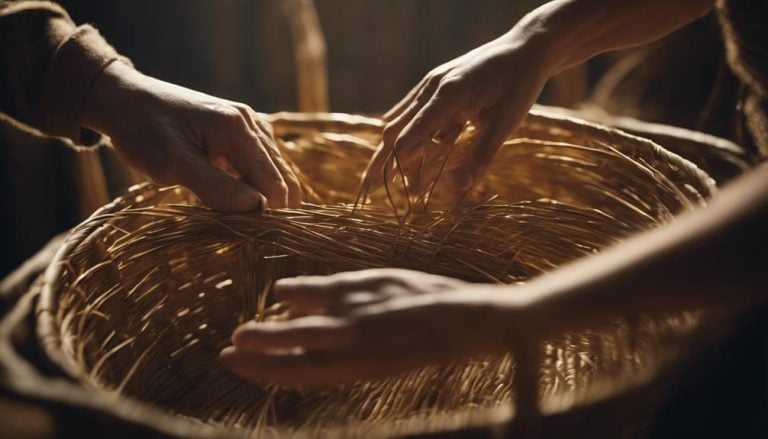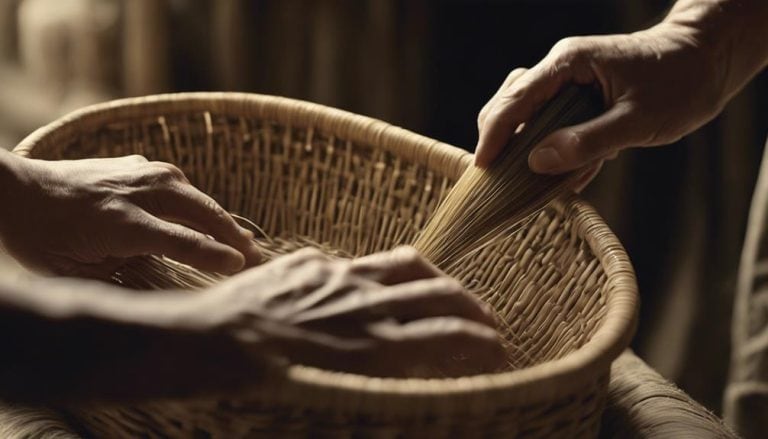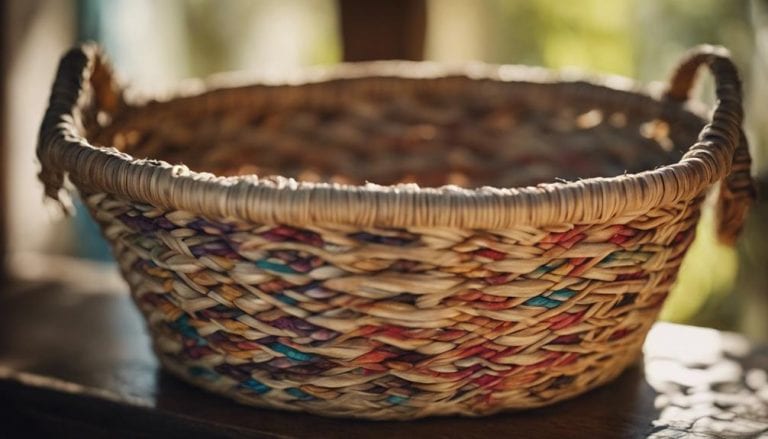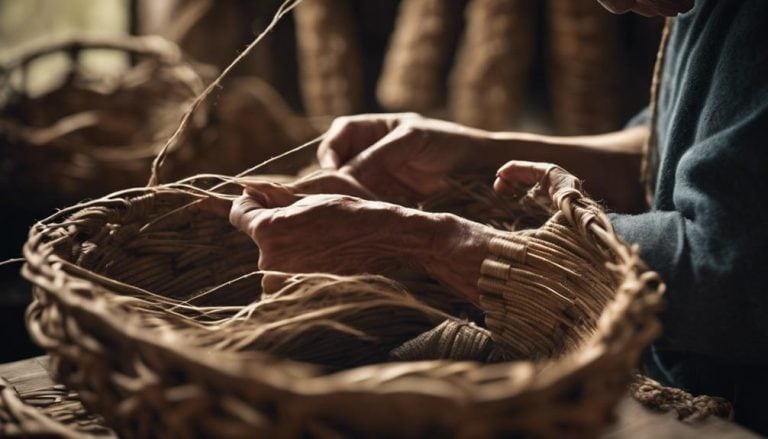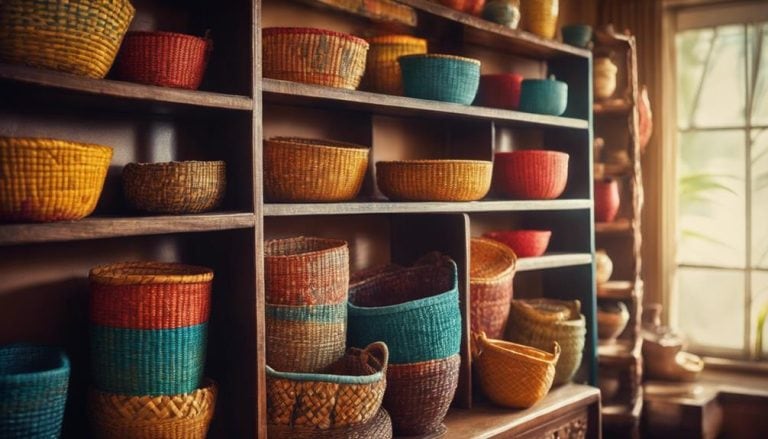Effective Maintenance of Woven Baskets
As the saying goes, 'A stitch in time saves nine.' When it comes to the effective maintenance of woven baskets, taking proactive steps can save you from future headaches and preserve the beauty and functionality of these timeless pieces.
But where to start? Well, let's just say that neglecting your baskets could lead to costly repairs or even the loss of cherished heirlooms.
In this discussion, we'll explore the essential tips and tricks for keeping your baskets in top shape, from proper cleaning techniques to the best storage practices. So, grab a seat and let's dive into the world of woven basket maintenance.
Key Takeaways
- Regular cleaning and deep cleaning are important for the longevity and appearance of woven baskets.
- Proper storage techniques, such as keeping baskets away from sunlight and in cool, dry environments, help prevent damage.
- When cleaning and repairing baskets, use gentle scrubbing and avoid harsh chemicals, and seek professional assistance for intricate or extensive damage.
- Reinforcing handles, joints, and high-stress areas helps prevent damage and maintain the structural integrity of the basket.
Importance of Regular Cleaning
Regular cleaning of woven baskets is essential for maintaining their longevity and preserving their appearance and structural integrity. Deep cleaning on a regular basis helps prevent dust and dirt from accumulating in the intricate weaves of the baskets. Over time, dust and dirt can settle into the fibers, causing them to weaken and deteriorate. By regularly cleaning the baskets, we can prevent this buildup and ensure that the baskets remain sturdy and durable.
Cleaning the baskets not only removes dust and debris, but it also helps to rehydrate the reed and prevent deterioration. The reed used in woven baskets can dry out over time, leading to brittleness and breakage. By cleaning the baskets with a damp cloth or gentle brush, we can moisturize the reed and keep it supple, preventing it from becoming brittle and prone to damage.
Furthermore, routine maintenance and cleaning can help preserve the overall appearance of the baskets. Dust and dirt can dull the colors and patterns of the baskets, making them lose their visual appeal. By regularly cleaning the baskets, we can keep them looking vibrant and fresh, enhancing their aesthetic value.
Proper Storage Techniques
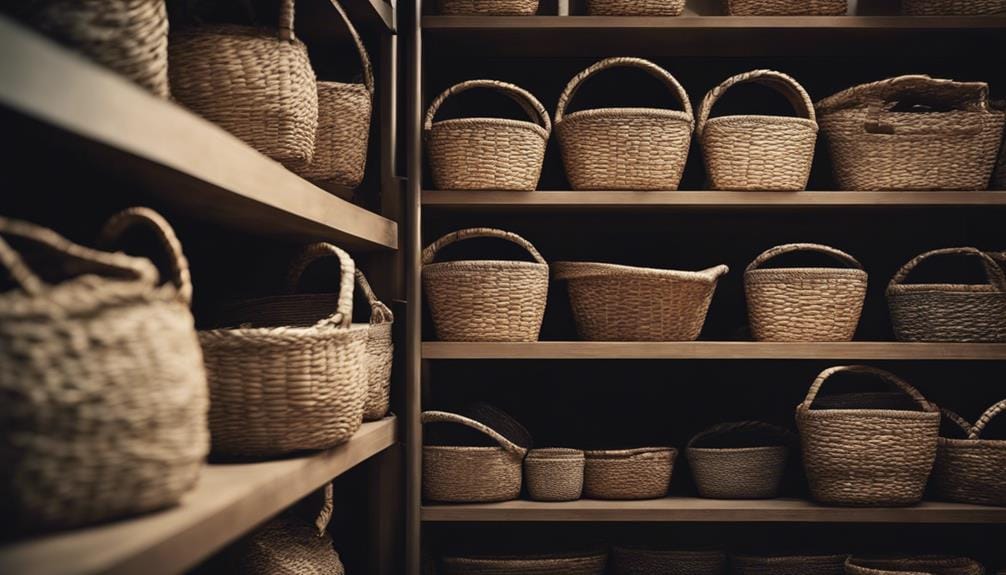
To ensure the longevity and preservation of woven baskets, proper storage techniques are crucial. Here are some steps you can take to store your baskets effectively:
- Find a cool, dry place: Store your woven baskets in an area that's free from excessive humidity and moisture. This will help prevent the growth of mold and mildew, which can damage the baskets over time.
- Use dustbags or covers: Protect your baskets from dust, dirt, and potential damage by using dustbags or covers. This will help keep them clean and in good condition.
- Avoid direct sunlight and extreme temperatures: Exposure to direct sunlight, artificial heat sources, or extreme temperatures can cause the baskets to fade, warp, or become brittle. Store them away from windows or heat vents to ensure their long-term preservation.
- Ensure baskets are completely dry: Before storing your woven baskets, make sure they're completely dry. Moisture buildup can lead to mildew growth and other issues. Allow them to air dry thoroughly before putting them away.
- Rotate baskets periodically: To prevent uneven wear and tear, it's a good idea to rotate your baskets periodically. This will vary their exposure to humidity, light, and other damaging factors, helping to maintain their overall condition.
Handling Baskets With Care
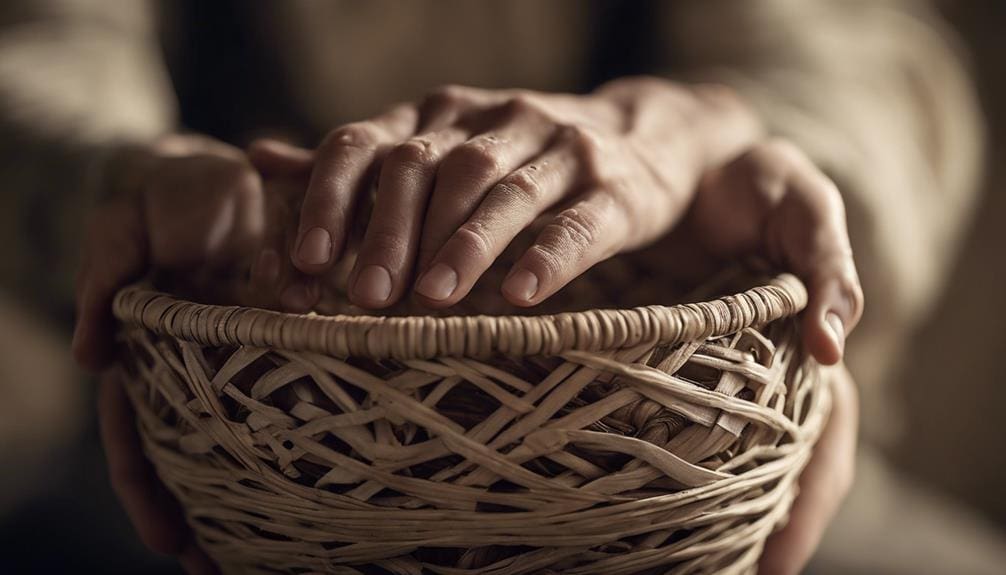
When handling woven baskets, it's important to exercise caution and care to protect their delicate structure and preserve their quality. Wicker baskets are crafted using a weaving technique that requires precision and attention to detail. To ensure their longevity, it's crucial to handle them properly.
Firstly, always make sure your hands are clean before touching the baskets. This will prevent dirt and oils from transferring onto the delicate wicker, which can cause discoloration and deterioration over time. Additionally, when lifting a basket, it's essential to support the bottom to prevent any unnecessary strain on the structure. This will help maintain the shape and prevent any potential damage.
In terms of storage, it's vital to avoid placing baskets in direct sunlight or near heat sources. Excessive exposure to these elements can cause the wicker to dry out and become brittle. This can lead to cracking and breakage. Instead, store baskets in a cool, dry area to maintain the integrity of the weaving.
Furthermore, it's advisable to use separate baskets for food storage to avoid contamination and maintain hygiene standards. This will prevent any potential transfer of food particles or odors onto the wicker, ensuring its cleanliness and longevity.
To clean the baskets, use a feather duster or a vacuum attachment to gently remove dust and debris. Avoid using harsh chemicals or abrasive materials, as these can damage the wicker.
Maintaining the Intended Use of Baskets
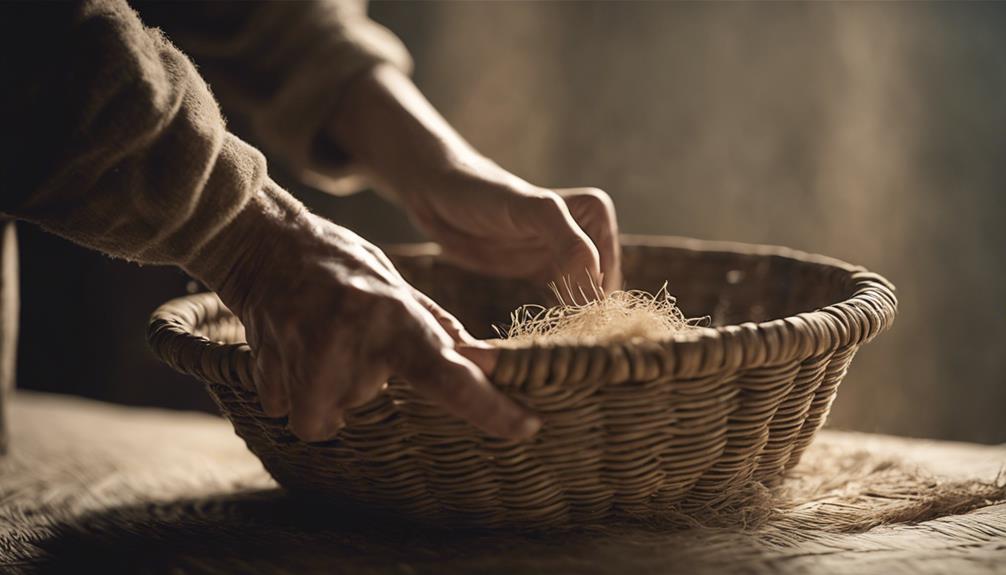
If we want to ensure that our baskets maintain their intended use and functionality, it's important to follow a few key steps in their maintenance and care. By keeping these tips in mind, we can ensure that our baskets remain in good condition for a long time.
First and foremost, it's crucial to keep our baskets dry. Excess moisture can lead to mold and mildew growth, which can compromise the structural integrity of the baskets. Make sure to store them in a dry area and avoid placing wet items directly into the baskets.
Additionally, it's important to use the baskets for their intended purpose. Different baskets are designed for different uses, such as food storage or decoration. To maintain hygiene and prevent cross-contamination, store food items in baskets meant for food storage. Use baskets designed for decorative purposes to store non-food items and keep them separate from food storage baskets.
Furthermore, it's essential to follow the manufacturer's guidelines for weight capacity. Overloading baskets can cause them to sag or break, rendering them unusable. By adhering to the weight limit recommended by the manufacturer, we can prevent structural damage and maintain the intended use of the baskets.
Regularly inspecting our baskets for wear and tear is also crucial. Addressing any issues promptly, such as loose weaves or broken handles, can prevent further damage and ensure the longevity of the baskets. Lastly, rotating baskets used for specific purposes can help distribute wear evenly, prolonging their lifespan.
Protecting Baskets From Sunlight and Heat Sources
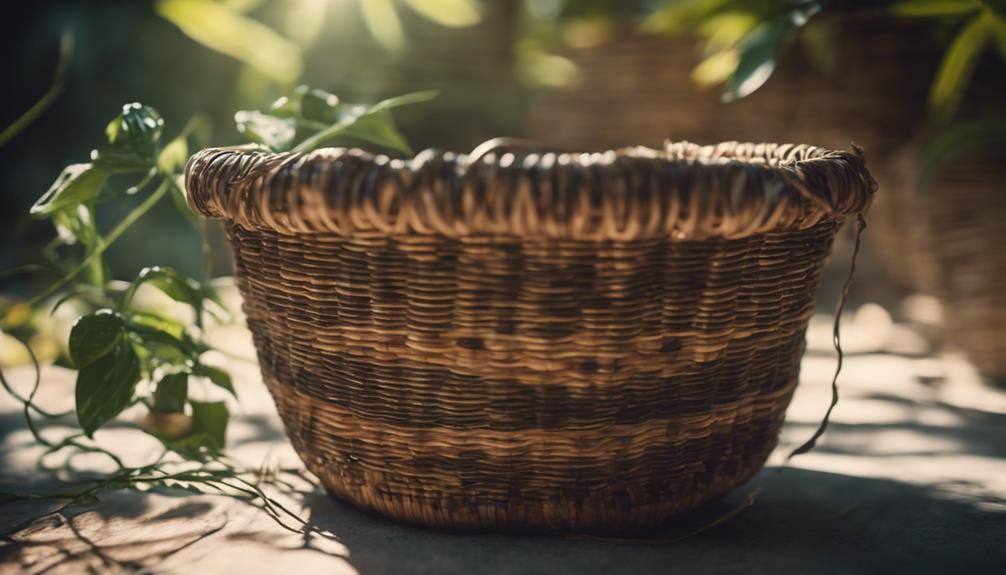
Exposing woven baskets to sunlight and heat sources can significantly impact their longevity and structural integrity. Wicker baskets, in particular, are vulnerable to the damaging effects of sunlight and heat. When these baskets are exposed to direct sunlight, the UV rays can cause the natural fibers to fade, weaken, and become brittle over time. Additionally, heat sources such as radiators or vents can dry out the fibers, leading to cracking and damage.
To protect woven baskets from sunlight and heat sources, it's important to keep them in shaded areas away from direct sunlight. Placing them near heat sources should also be avoided to prevent the risk of fire hazards, especially with flammable materials like wicker. It's recommended to store baskets in cool and dry environments to maintain their structural integrity.
Furthermore, ensuring that the baskets are completely dry before storing them can also prevent moisture damage. Moisture can weaken the fibers and promote mold or mildew growth, which can further compromise the basket's durability. Regularly inspecting the baskets for signs of damage or fading and taking appropriate measures to protect them from sunlight and heat can significantly prolong their lifespan and maintain their functionality.
Repairing and Maintaining Damaged Baskets
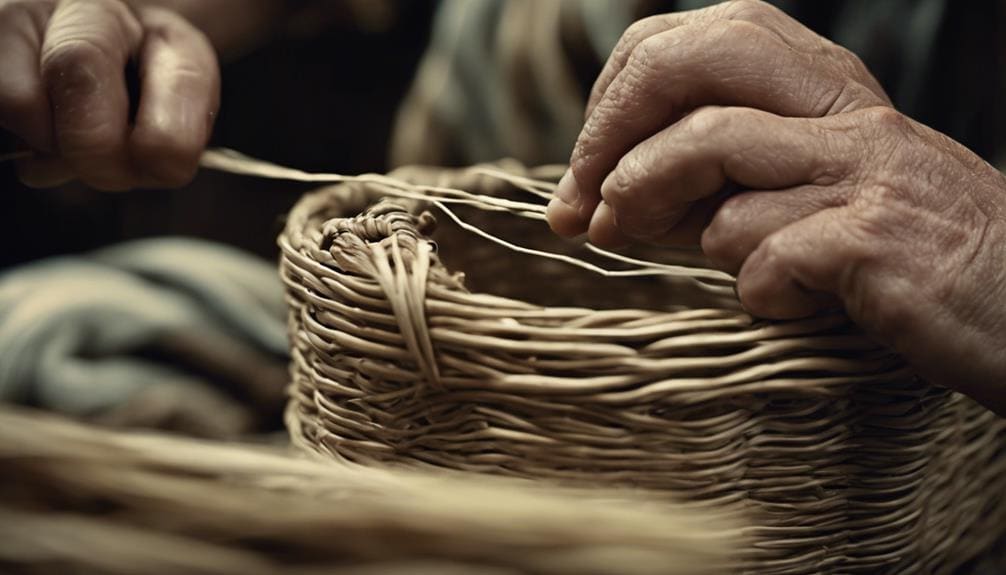
To properly maintain and restore damaged baskets, it's crucial to identify the type of damage present, whether it be broken reeds, loose weaves, or structural weaknesses. Once the damage has been assessed, there are several steps you can take to repair and maintain the basket:
- Begin by gently cleaning the basket with a solution of mild dish soap and warm water. This will help remove any dirt or grime that may have accumulated over time.
- For minor damage such as broken reeds or loose weaves, you can use matching wicker or straw materials to carefully repair the affected areas. This will ensure that the basket maintains its original aesthetic.
- Reinforce areas that are under pressure, such as handles or structural joints, to prevent further damage. This can be done by adding additional weaves or using a stronger material for support.
- It's important to avoid using tape or adhesive on damaged baskets, as this can cause further harm. Instead, consult a basket repair expert or conservator for specialized repairs.
- For intricate or extensive damage, it's recommended to seek professional repair services to ensure proper restoration.
Frequently Asked Questions
How Do You Maintain Woven Baskets?
To maintain woven baskets, I clean them gently with a feather duster or vacuum attachment. I store and display them using appropriate wall hangers and protective cases to keep them safe from pets and children.
How Do You Keep Woven Baskets From Drying Out?
To prevent moisture loss and preserve the natural colors of woven baskets, I keep them in a cool, dry place, away from direct sunlight or extreme temperatures. I also use a humidifier and regularly condition the material to keep it hydrated.
Should You Oil Your Baskets?
Yes, you should oil your baskets occasionally to maintain their flexibility and prevent them from drying out. However, alternative preservation methods like using wax or varnish can also be effective. Oiling may darken the basket's colors, so consider the impact on aesthetics.
How Do You Condition Old Baskets?
To condition old baskets, I mist them with a mixture of glycerine and warm water to rehydrate them. I store them in a cool, dry place, inspect them regularly for damage, and avoid direct sunlight and extreme temperatures. Seeking advice from professionals is also helpful.
Conclusion
In conclusion, maintaining the longevity and preservation of woven baskets requires diligent care and attention to detail.
By regularly cleaning them, handling them with care, and storing them properly, we can ensure their quality and prevent damage.
Just as a well-woven basket holds the pieces of our lives together, our careful maintenance and protection of these baskets keeps their stories alive for generations to come.



